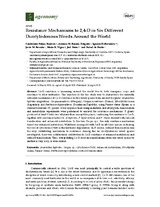Mostrar el registro sencillo del ítem
Resistance Mechanisms to 2,4-D in Six Different Dicotyledonous Weeds Around the World
| dc.contributor.author | Palma-Bautista, Candelario | |
| dc.contributor.author | Rojano Delgado, Antonia M. | |
| dc.contributor.author | Dellaferrera, Ignacio | |
| dc.contributor.author | Rosario, Jesús M. | |
| dc.contributor.author | Vigna, Mario R. | |
| dc.contributor.author | Torra, Joel | |
| dc.contributor.author | Prado, Rafael de | |
| dc.date.accessioned | 2020-04-14T19:34:36Z | |
| dc.date.available | 2020-04-14T19:34:36Z | |
| dc.date.issued | 2020 | |
| dc.identifier.uri | http://hdl.handle.net/10396/19904 | |
| dc.description.abstract | 2,4-D resistance is increasing around the world due to both transgenic crops and resistance to other herbicides. The objective of the this study was to characterize the currently unknown mechanisms of 2,4-D resistance in five weed species from around the globe: Amaranthus hybridus (Argentina), Conyza canadensis (Hungary), Conyza sumatrensis (France), Hirschfeldia incana (Argentina) and Parthenium hysterophorus (Dominican Republic), using Papaver rhoeas (Spain) as a standard resistant (R) species. Dose-response trials using malathion and absorption, translocation and metabolism experiments were performed to unravel the resistance mechanisms. R plants produced at least 3-folds less ethylene than susceptible plants, confirming the resistance to 2,4-D, together with resistance factors >4. A. hybridus, P. hysterophorus and P. rhoeas showed both reduced translocation and enhanced metabolism. In the two Conyza sps., the only resistance mechanism found was enhanced metabolism. Malathion synergized with 2,4-D in all these species, indicating the role of cytochrome P450 in the herbicide degradation. In H. incana, reduced translocation was the only contributing mechanism to resistance. Among the six dicotyledonous weed species investigated, there was a differential contribution to 2,4-D resistance of enhanced metabolism and reduced translocation. Thus, extrapolating 2,4-D resistance mechanisms from one weed species to another is very risky, if even related. | es_ES |
| dc.format.mimetype | application/pdf | es_ES |
| dc.language.iso | eng | es_ES |
| dc.publisher | MDPI | es_ES |
| dc.rights | https://creativecommons.org/licenses/by/4.0/ | es_ES |
| dc.source | Agronomy 10(4), 566 (2020) | es_ES |
| dc.subject | Amaranthus hybridus | es_ES |
| dc.subject | Conyza sp. | es_ES |
| dc.subject | Cytochrome P450 | es_ES |
| dc.subject | Enhanced metabolism | es_ES |
| dc.subject | Hirschfeldia incana | es_ES |
| dc.subject | Papaver rhoeas | es_ES |
| dc.subject | Parthenium hysterophorus | es_ES |
| dc.subject | Reduced translocation | es_ES |
| dc.title | Resistance Mechanisms to 2,4-D in Six Different Dicotyledonous Weeds Around the World | es_ES |
| dc.type | info:eu-repo/semantics/article | es_ES |
| dc.relation.publisherversion | http://dx.doi.org/10.3390/agronomy10040566 | es_ES |
| dc.relation.projectID | Gobierno de España. AGL2016-78944-R | es_ES |
| dc.relation.projectID | Gobierno de España. AGL2017-83325-C4-2-R | es_ES |
| dc.relation.projectID | Gobierno de España. RYC2018-023866-I | es_ES |
| dc.rights.accessRights | info:eu-repo/semantics/openAccess | es_ES |

